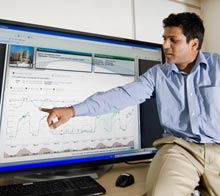PCs that Work While They Sleep
SleepServer creates a virtual copy of a dozing machine.
Software that lets desktop computers continue to function in sleep mode could reduce the energy consumption of office networks by around 60 percent.
Networked PCs are increasingly being left on 24/7 to allow for out-of-hours access by employees, says Yuvraj Agarwal, at the University of California, San Diego. "The administrator may want to do a backup, or the user may want to be able to connect into it," he says. But most of the time these PCs remain idle, wasting significant amounts of energy, he says.
 |
| Energy saver: Yuvraj Agarwal demonstrates the SleepServer control software. Credit: UC San Diego / Erik Jepsen |
Agarwal's solution, developed with two UCSD professors, Stefan Savage and Rajesh Gupta, is to create a stripped down, virtual copy of a machine. Software running on a remote server maintains a version of a PC's operating systems and applications. The software, called SleepServer, carries on tasks on behalf of the desktop machine while it is put into a low-energy sleep mode.
This lets SleepServer perform basic tasks on behalf of the PC, such as downloading files or staying logged into voice communications or instant-messaging software. When more complex activity is required, the software wakes up the computer, says Agarwal, a process that typically takes less than 10 seconds.
"Normally if I put my computer to sleep, then Skype is going to show that I'm offline, or I won't be able to continue downloading a large file from the Internet," says Agarwal. SleepServer maintains a fast connection, over the internal network, to each desktop, so any files it has downloaded on behalf of a PC can be transferred quickly.
The energy savings come from the fact that each server can host up to 500 virtual machines. Even the latest low-power computers consume around 45 watts of power when idle. In contrast, a single SleepServer machine runs at just 300 watts, Agarwal says. Using fully functional virtual machines and low power "thin client" desktop machines could reduce power consumption further still.
In trials, details of which were presented at the USENIX Annual Technical Conference in Boston last week, 30 PCs used SleepServer for two weeks. The energy they consumed was dropped by between 27 and 86 percent--an average reduction of 60 percent, says Agarwal. With up to 80 percent of electricity consumption in modern offices coming from computing equipment, the savings a SleepServer offers could be roughly equivalent to $60 per computer each year, he says. Fifty PCs in the computer science building of UCSD are now running SleepServer.
Other software can be used to wake up sleeping computers, such as Apple's Wake-on Demand and Microsoft's Sleep Proxy. But these applications do not carry out tasks on behalf of a sleeping machine.
"It's a clever approach," says Howard Noble, principle investigator of the Low Carbon Information and Communication Technology Project, at the University of Oxford, in the U.K.
But Noble says it would be preferable to be able to power down computers completely. Modern computers can still consume as much as five watts when asleep. "We have never found it to be reliable, because often they don't stay asleep," he says.

















0 comments:
Post a Comment
Please do not spam Spam comments will be deleted immediately upon my review.